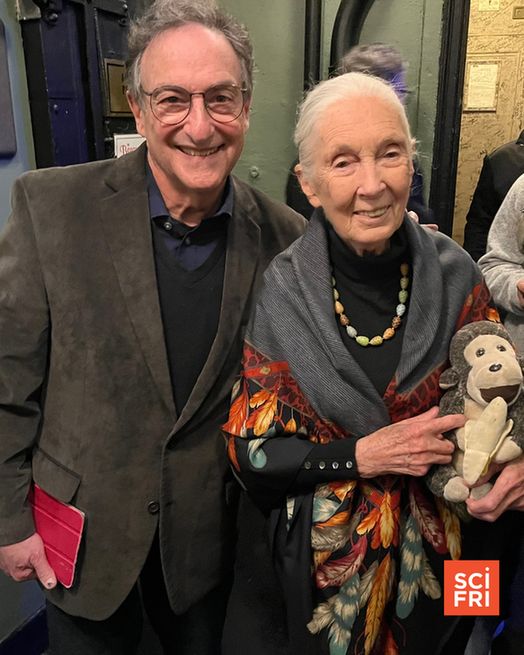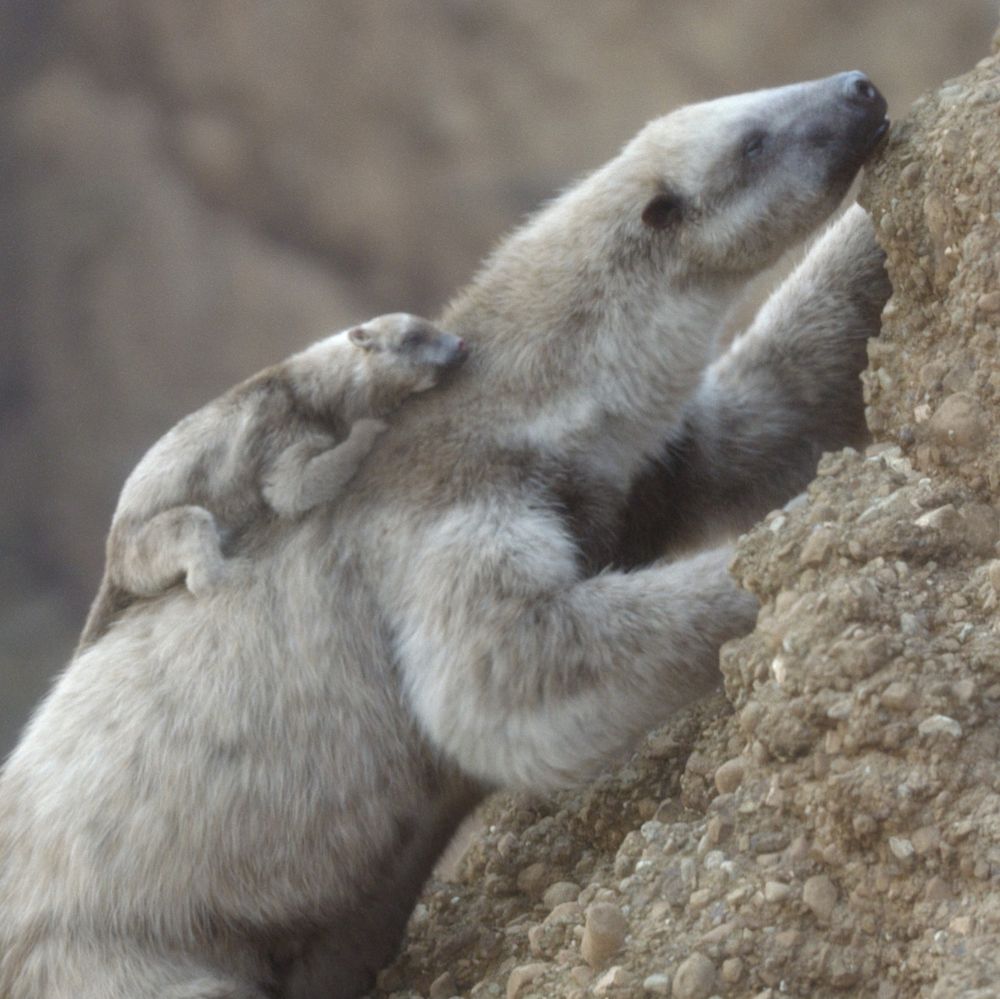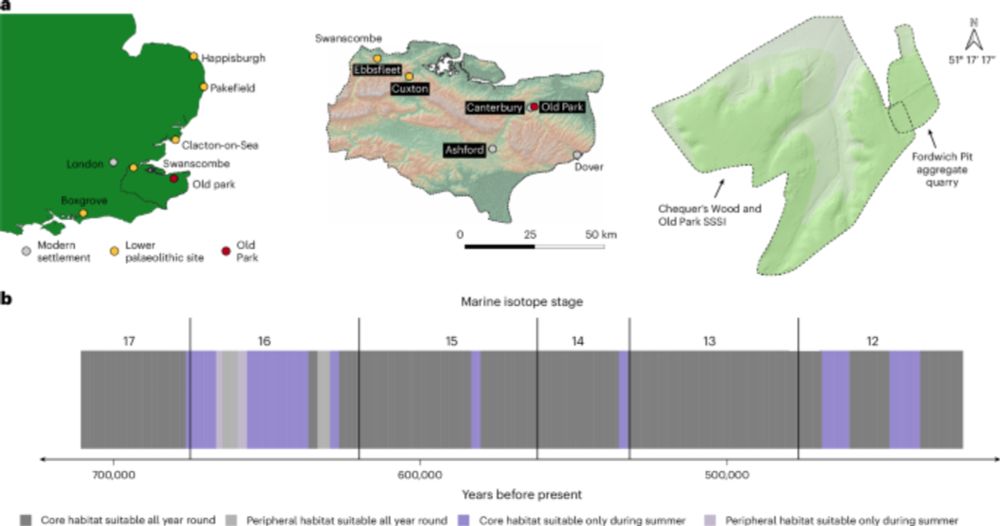
Dynamic omnivory shapes the functional role of large carnivores under global change - Nature Communications
Omnivores like bears can switch between plant and animal diets, potentially helping them respond to changing conditions. By combining modern and fossil data, this study shows that bears shift toward c...
A New study shows bears' diet dynamically shifts the omnivore-herbivore spectrum depending on #ecosystem productivity. Basically, #bears 🐻 adjust their diet with climate + resource availability 🌿. And this has huge implications for modern conservation and interpretations about past ecosystems 🧪🦣
07.12.2025 08:53 — 👍 3 🔁 0 💬 0 📌 0

Homo sapiens-specific evolution unveiled by ancient southern African genomes - Nature
The genomes of 28 ancient southern African individuals dated to between 10,200 and 150 years before present offer insights into the evolution of Homo sapiens.
Our new ancient DNA paper has just been published!
We present 28 new genomes from southern Africa - several of them high-coverage whole genomes.
Exciting to be moving towards population-level representation of ancient southern African genetic diversity!
www.nature.com/articles/s41...
03.12.2025 16:42 — 👍 114 🔁 51 💬 5 📌 3

The dog domestication: new ichnological evidence from the Upper Palaeolithic of the Bàsura cave (Toirano, NW Italy)
The Grotta della Bàsura (Bàsura Cave) provides invaluable evidence of human-canid interactions during the Upper Palaeolithic. It offers unique insight…
In a cave in Liguria, ca. 14 thousand years ago, a group of humans and a single dog walked together in a cave and explored its depths. Their overlapping footprints and tracks are one of the oldest direct evidence of human-dog interactions 🐾🐕 #DogDomestication 🦣🏺🧪
24.11.2025 08:46 — 👍 15 🔁 1 💬 0 📌 1

Highly selective cannibalism in the Late Pleistocene of Northern Europe reveals Neandertals were targeted prey - Scientific Reports
Scientific Reports - Highly selective cannibalism in the Late Pleistocene of Northern Europe reveals Neandertals were targeted prey
New paper on #Neandertal #cannibalism from Goyet 👀🦴 Turns out the victims were mostly short-stature females & juveniles, likely outsiders. More than survival cannibalism evidence points to inter-group predation or deeply social conflict... #Paleolithic #Paleoanthropology
21.11.2025 21:05 — 👍 4 🔁 0 💬 0 📌 0

So proud to see our new paper out in PNAS spearheaded by @emilypigott.bsky.social She found a tiny 46,000 yr old Neanderthal bone at Starosele (Crimea). DNA work revealed long-distance connections across Eurasia, supported by stone tool evidence @heasvienna.bsky.social
www.pnas.org/doi/10.1073/...
29.10.2025 09:17 — 👍 69 🔁 26 💬 2 📌 1

Faunal persistence and ecological flexibility in Pleistocene Southeast Asia revealed through multi-isotope analysis
Multi-isotope approaches provide valuable insights into mammalian ecological niches and factors contributing to extirpation.
A new landmark study of fossil teeth confirms that adaptable generalists survived Pleistocene climate shifts, while specialized picky eaters went extinct. This warns that modern conservation must prioritize habitat diversity to build the resilient ecosystems essential for survival.
#Conservation 🧪🦣
21.10.2025 13:05 — 👍 3 🔁 0 💬 0 📌 0

Reconstructed left hand of KNM-ER 101000.
New fossils reveal the hand of Paranthropus boisei🏺🧪
C. Mongle, Meave Leakey, @louiseleakey.bsky.social et al
www.nature.com/articles/s41...
Suggests P. boisei capable of tool making and use in some capacity while also supports proposed dichotomy of dietary adaptations between Paranthropus and Homo
17.10.2025 15:31 — 👍 23 🔁 10 💬 0 📌 0

Ancient DNA and dating evidence for the dispersal of hippos into central Europe during the last glacial
Arnold et al. present evidence that Late Pleistocene hippos from the Upper Rhine Graben
show close genetic ties to modern African hippos. Although hippos have been thought
to have gone extinct around ...
Turns out #hippos 🦛 lived in Europe much more recently than we thought!
Fossil & genetic evidence from Germany shows they roamed 50,000–31,000 years ago, right in the middle of the last #iceage 🥶🌨️
Same species as today’s African hippos, thriving during warmer periods.
🦣🧪🧬
09.10.2025 16:53 — 👍 26 🔁 10 💬 0 📌 0
Wow! This is a nice news 👇
03.10.2025 13:39 — 👍 2 🔁 0 💬 0 📌 0

Photo of Ira Flatow and Jane Goodall taken in 2024 during her 90th birthday celebration."

Photo of Ira Flatow and Jane Goodall taken in 2020.
"I do know that when talking to people who perhaps think very differently, the only chance you have of getting them to think in a different way is to touch the heart." — Dr. Jane Goodall (1934-2025)
Thanks, Jane, for touching our hearts.
01.10.2025 21:18 — 👍 307 🔁 47 💬 4 📌 0
True! Also, cheetahs are not even big cats (but I still love them ahah)
01.10.2025 12:46 — 👍 2 🔁 0 💬 0 📌 0

New discovery! Here @mariaguagnin.bsky.social and our team report on 12,000-year-old life-size camel rock art engravings in the Saudi desert. #GreenArabia @griffith.edu.au www.nature.com/articles/s41...
30.09.2025 15:34 — 👍 21 🔁 7 💬 0 📌 0

The earliest evidence of blue pigment use in Europe | Antiquity | Cambridge Core
The earliest evidence of blue pigment use in Europe
The oldest use of blue pigment in Europe! 💙
At Mühlheim-Dietesheim (Germany), traces of azurite were found on a Final Palaeolithic artefact challenging the idea that blue was absent from Ice Age art.
So interesting! 🤔 Why hasn’t it been found elsewhere? Body paint, lost contexts?
🦣🏺🧪 #Paleolithic
29.09.2025 11:01 — 👍 8 🔁 0 💬 0 📌 0
Merci mon cher!
28.09.2025 11:50 — 👍 0 🔁 0 💬 0 📌 0
Thanks Roman!!
27.09.2025 16:57 — 👍 0 🔁 0 💬 0 📌 0


Thrilled to have won the Student Poster Prize at #ESHE2025! 🏆 Grateful for the opportunity to share my work on Lebanese fauna and for all the inspiring conversations throughout the conference!
27.09.2025 16:14 — 👍 23 🔁 4 💬 2 📌 1
Yesterday I had the pleasure of presenting my poster on large carnivore 🐆 exploitation in Lebanon at #ESHE2025. Such a great venue for it, with so many interesting posters around! I also got the chance to chat with lots of amazing people! #Paleolithic #zooarcheology 🏺🦣🧪
27.09.2025 08:06 — 👍 14 🔁 0 💬 0 📌 1
Great talk @armandofalcucci.bsky.social! Impressive depth of data analysis, and I really appreciated the open science approach. Finally, robust evidence that the Ahmarian and Protoaurignacian aren’t directly linked
#Paleolithic #lithics 🏺🦣🧪
26.09.2025 08:17 — 👍 8 🔁 2 💬 0 📌 0


#ESHE2025 kicks off on 24 Sept with tours at the NHMN in Paris, followed by a keynote panel on the 25th, conference talks, posters (25th to 27th) & an excursion to Resson and Grotte à la Peinture on the 28th. More info here: bit.ly/3G9CeiQ
14.04.2025 09:14 — 👍 33 🔁 11 💬 0 📌 1

AI is helping to decode animals’ speech. Will it also let us talk with them?
The complexity of vocal communication in some primates, whales and birds might approach that of human language.
#AI is opening a window into #animal #communication, bonobos build phrases, whales craft alphabets 🐒🐋 It’s thrilling to imagine talking back, but... what if our words change their world forever?
Here is a good read to stay updated
20.09.2025 22:30 — 👍 0 🔁 0 💬 0 📌 0

Imagine a rhino horn longer than most people are tall… Woolly rhinos had them! Record-breaking 1.65 m nasal horn found in Siberia belonged to a 40+ year-old female 🦏❄️
#Paleontology #IceAge #Prehistory 🧪🦣
Paper 👇
zslpublications.onlinelibrary.wiley.com/doi/10.1111/...
18.09.2025 15:20 — 👍 4 🔁 0 💬 0 📌 0

NYAS Publications
The traditional view regarding Homo habilis as the primary agent in stone-tool making and animal butchery has long shaped our understanding of human evolution. Recent advances in artificial intellige....
A new cool research using AI reveals that Homo habilis fossils 💀 show #leopard bite marks 🐆 For decades, Homo habilis was cast as a toolmaker, meat-eater, or even predator. But this study shows that at least some were actually leopard prey!
#AI #Archeology 🧪🏺🦣
18.09.2025 15:09 — 👍 4 🔁 1 💬 0 📌 0

Prehistoric Planet Ice Age homotheres, white and touching faces together.

Prehistoric Planet Ice Age Woolly rhino old adult and youngster.

Prehistoric Planet Ice Age Glyptotherium.

Prehistoric Planet Ice Age sloth mother with juvenile on back.
Prehistoric Planet Ice Age out later this year... such a thrill to put this series together, oh my goodness are you in for a treat :) Hopefully news on events and publicity coming soon! Sloths, cats, rhinos, glyptodonts AND SOOOO MUCH MORE!!
10.09.2025 08:17 — 👍 484 🔁 128 💬 20 📌 25
They finally added the #bookmark 🔖 feature! Finally 💙
11.09.2025 20:09 — 👍 1 🔁 0 💬 0 📌 0

Dental microwear of cave bear (Ursus spelaeus) reveals locally adapted foraging strategies in South-Eastern Europe during late MIS 3
Cave bears (Ursus spelaeus sensu lato) represent a remarkable example of Late Pleistocene megafauna, whose ecology and extinction dynamics remain a su…
New study of cave #bear tooth microwear 🐻🦷 shows they weren’t strict herbivores but had seasonal, opportunistic diets, like modern bears. This flexibility, plus niche overlap with brown bears, offers a more complex picture of their path to extinction!
#zooarchaeology 🦣🏺
19.08.2025 17:06 — 👍 5 🔁 0 💬 0 📌 0
The Society of Vertebrate Paleontology is made up of university, museum, and public lands professionals, as well as artists, students, and others interested in VP. The society is organized exclusively in support of educational and scientific purposes.
Arqueólogo e ilustrador en continua formación
✨Un higo chumbo y una aceituna
Research Fellow, Corpus Christi College, University of Cambridge | Palaeoanthropology and Palaeolithic Archaeology | He/Him
Paleoanthropologist and CNRS junior professor at @palevoprim (CNRS & University of Poitiers).
News from the #Paleoanthropology 🦴🦷⚒️ lab at the University of Tübingen 🎓 & Senckenberg 🌍
Award-winning author #PlatypusMatters & #NaturesMemory. Assistant Director of @ZoologyMuseum.bsky.social at Cambridge Uni. President of the Society for the History of Natural History. Australian mammal nerd. He/him. Own views.
Mammalian paleontologist @unihalle.bsky.social & @mfnberlin.bsky.social | islands 🏝, paleoecology ⏳, conservation paleobiology, bovids 🐐🐃🐂 | Also 🎶
Staff writer @LiveScience.com
Email: kkillgrove@livescience.com
Web: Livescience.com/author/kristina-killgrove
PhD in anthropology, MA in classical archaeology. Former professor & Roman bioarchaeologist.
I crochet and bake a lot. Time zone: US Eastern
Institut du CNRS spécialisé en écologie et environnement.
Comprendre la biosphère pour agir.
#biodiversité 🦋🌺 #écosystème 🏞️ #préhistoire ⌛️ #océan 🌊
Cutting-edge research, news, commentary, and visuals from the Science family of journals. https://www.science.org
We are interested in how animals (including humans) respond(ed) and adapt(ed) to changing environments.
Department of Zoology, Cambridge, UK.
PI: Prof. Andrea Manica (he/him)
Website: https://evolecolgroup.github.io/website/
Assistant Professor, UBC Zoology & Botany
Wildlife ecology, animal behaviour, predator-prey interactions, conservation
A project of The Center For Scientific Integrity https://centerforscientificintegrity.org/
Daily newsletter http://eepurl.com/bNRlUn
Database http://retractiondatabase.org
Tips team@retractionwatch.com (better than @ replies)
Official bluesky account of the European Society for the study of Human Evolution. Email us communication@eshe-conference.eu
www.eshe.eu
Researcher in biological anthropology, paleoanthropology, skeletal trauma.
Lab at University of Reading using #archsci #Palaeoproteomics #ZooMS and #Zooarchaeology 🦌🦏🦴🐂 to study past human behaviour; home to project COEXIST. PI Karen Ruebens.
Scientist: #biodiversity, #macroecology, #climatechange, #restoration & #rewilding, #novelecosystems, #plants & #vegetation, #megafauna, #human-#nature relations & #remotesensing. Director, https://econovo.au.dk/
Evolutionary archaeologist at-large interested in cultural transmission, environmental/computational archaeology, and novel ecosystems. Professor, papa, pizza-lover.
https://scholar.google.com/citations?user=sfHIPiabSMwC&hl=en




























